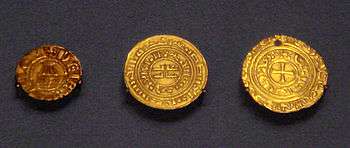Modern gold dinar
The modern Islamic gold dinar (sometimes referred as Islamic dinar or Gold dinar) is a currency that aims to revive the historical gold dinar which was a leading coin of early Islam. They consist of minted gold coins, dinar, and silver coins, dirham.
Dinar history

According to Islamic law, the Islamic dinar is a coin of pure gold weighing 72 grains of average barley. Modern determinations of weight range from 4.44 grams to 4.5 grams of gold, with the silver Dir-ham being created to the weight ratio of 7:10, yielding coins from 3.11 to 3.15 grams of pure silver.
Umar Ibn al-Khattab established the known standard relationship between them based on their weights: 7 dinars must be equivalent (in weight) to 10 dirhams.
| “ | The Revelation undertook to mention them and attached many judgements to them, for example zakat, marriage, and hudud, etc., therefore within the Revelation they have to have a reality and specific measure for assessment of zakat, etc. upon which its judgements may be based rather than on the non-shari'i other coins. Know that there is consensus since the beginning of Islam and the age of the Companions and the Followers that the dirham of the shari'ah is that of which ten weigh seven Mithqals weight of the dinar of gold... The weight of a Mithqal of gold is seventy-two grains of barley, so that the dirham which is seven-tenths of it is fifty and two-fifths grains. All these measurements are firmly established by consensus. |
” |
Value and denomination
Per the historical law stated above, one dinar is 4.44 grams of pure gold, while one dirham is 3.11 grams of pure silver. A smaller denomination, daniq, weighs one sixth as much. The value of each coin is according to their weight and the market value of the two metals. The coins may be minted at fraction or multiples of their weights and valued accordingly.
Adoption
Indonesia
The currency was introduced in Indonesia in the year 2000 by the Islamic Mint Nusantara (IMN). In 2011, IMN began the Mithqal correction by minting the dinar at 4.44 grams (1/7 troy ounce) at a fineness of 999.9 ‰ and the dirham at 3.11 grams (1/10 troy ounce) at a fineness of 999.9‰.[1]
Malaysia
In 2002, the prime minister of Malaysia proposed a gold dinar standard for use in the Islamic world.[2]
Kelantan was the first state in the country to introduce the dinar in 2006, which was locally minted. In 2010, it issued new coins, including the dirham, minted in the United Arab Emirates by the World Islamic Mint.[3] On 25 August 2013 Kelantanese government collected and distributed zakat from people in Kelantanese dinars and dirhams in a public ceremony officiated by Chief Minister Dato Nik Aziz Nik Mat.[4]
The state of Perak followed suit, minting its own dinar and dirham, which was launched in 2011.[5]
Islamic State of Iraq and the Levant
The leader of the UN-designated terrorist group Islamic State of Iraq and the Levant, Abu Bakr al-Baghdadi, announced in November 2014 that the Caliphate intended to mint its own gold, silver and copper coins in order to free the Muslims from the financial order that has "enslaved and impoverished" them.[6]
The currency would be based on the dinar coins minted by the Caliphate of Uthman ibn Affan and include seven coins: two gold, three silver and two copper, ranging in value from 7¢ to $694, their values based on the intrinsic value of the metals.[7] The gold dinar is weighted at 4.25 grams and is made of 21 karat gold.
Other groups
Abdalqadir as-Sufi, founder of the Murabitun World Movement, was once a strong proponent of the idea for the gold dinar revival movement, but in February 2014 he completely distanced himself from it, saying, "So, I now dis-associate myself from all activity involving the Islamic gold dinar and silver dirham".[8] Trinidadian scholar Imran Nazar Hosein has also been promoting the revival of Dinar usage, but has linked its use to Islamic eschatology.
Use
Most of the coins are issued privately and are not legal tender. In Malaysia, the state government of Kelantan allows their use in transactions while it is illegal according to federal law.
Common uses of the gold dinar include:
- Buying merchandise from outlets.
- Holding accounts, and making and receiving payments as with any other medium of exchange.
- Saving, as is done with any form of gold.
- Paying zakat and mahr as established within Islamic Law.
See also
Notes
- ↑
- ↑ "Starkers". The Economist. Retrieved 27 December 2015.
- ↑ The Malaysian Insider, Kelantan launches gold dinar, August 12th 2010.
- ↑ "IslamDag.info". Retrieved 27 December 2015.
- ↑ New Strait Times, Silver state launches dinar, dirham coins, March 1st 2011.
- ↑ "Isis to mint own Islamic dinar coins in gold, silver and copper", The Guardian, 14 November 2014
- ↑ "Islamic State announces its own currency", The Telegraph, 14 November 2014
- ↑ "THE ISLAMIC DINAR – A WAY-STAGE PASSED" Shaykh Dr. Abdalqadir as-Sufi
References
- Ahamed Kameel Mydin Meera, The Islamic gold dinar, Pelanduk Publications, 2002, ISBN 978-967-978-825-9
External links
- The Gold Dinar and Silver Dirham - authored by Imran Nazar Hosein
- The Economist, October 16th 2003, Times are changing